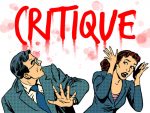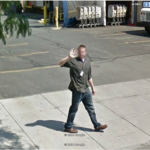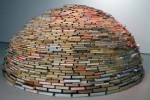search
- Vladimir Miller / Peter Stamer
- a.pass
- 05 July 2016
- 07 July 2016
- case of: Vladimir Miller
- Peter Stamer / Luanda Casella
- 29 June 2015
- 03 July 2015
- PIERRE RUBIO / PETER STAMER
- 24 June 2013
- 28 June 2013
- case of: Pierre Rubio
- Peter Stamer / Nicolas Galeazzi
- 16 March 2013
- 20 March 2013
- 'give it away' First, you are going to enclose and extract a section from the complex of your research case. This may be a part you don't know how to deal with, a part you would like to be infected by with foreign qualities, or a section you already gave up. Then you condense this section to a 'package' - readable for an 'anybody' - and release it from your personal care. You put it on disposal to be adopted by someone else – maybe by means of a lottery. Everyone who is involved will give away part of his research and receive parts of others – adoption is based on mutuality.
- 'care about' In the following adoption phase you will hence be in charge for a package yourself. You will feel responsible for the assignment delivered to your hands. You will have to take up a stance for it, to care for it and to charge it with the best of your intentions and qualities. You will approach it through your own eyes and tools and, as you adopt it, you will treat it as if it would be yours and use if it was for your own purposes.
- 'give it back' Changed, charged and re-bundled you will give the adopted package back from the foster-artist to the mother-artist. The third phase will happen in PA-F, where you will hand it over to the mother-artist in the context of his/her research presentation.
The Adoption Project 16 March 2013
posted by: Nicolas GaleazziHow do you position yourself to your art?
How tight is the bond between you and the issues or ideas you are working with?
What if you would release this bond and adopt out parts of your research temporally to someone else?
The Adoption Project takes on the bonds and habits between you and your artistic practice. It challenges the perspectives and positions you engage with in your artistic process and takes them away from your personal involvement by handing them over to a different look, practice, or routine for a certain period of time. A clear defined section of your project shall be packed in a 'box' and given up for adoption, while you will take a section of someone else's research temporally under your 'protection'.
In this sense the Adoption Project aims to facilitate you with tools to put your proper work in a public sphere long before it is 'completed'. We understand this process as an effective instrument of research.
How does it work?
Timeframes:
Introduction to the project during the opening week in January. First working phase during the Half-way-days, February 18th and 19th. Second phase Workshop, March 18th to 22nd. Third phase in Pa-f, March 30th to April 5th.
APPLY TO THE A.PASS PROGRAMMESOpen Call
SIGN UP TO EVENTORDER
HOW ABOUT CRITIQUE, CRITICALITY, CRISIS? 24 June 2013
posted by: Pierre Rubio
Every block, a.pass organizes ‘b-workshops’ that focus on the basic principles of a.pass as a working environment. ‘How about Critique, Criticality, Crisis?’ ties in on a field already explored by ‘Feedback and Critique’ in July 2012. Whereas the previous workshop focused on several feedback techniques to clarify the nature(s) and function(s) of feedback within a collaborative and self-organized artistic research environment, this one will focus on the challenging issue of ‘critique’.
What does critique aim at, and how does it epistemologically operate? How can we deal with its problematic relation to judgment and truth? What’s the relevance of critique within a system of criticality to overcome the vicious circle of belief and denunciation? What’s the role of discourse and theory in one’s research and practice in order to go beyond backing up one’s work but rather challenging it, eroding it, posing problems to it? Is discourse solving the crisis of practice or should it rather impose a crisis on practice?
From critical readings of several texts on critique and criticality to film and performance analysis, from case studies to role-playing, we will come up with refreshed definitions of critique and renewed objectives of uncompromising aesthetic.
SIX DEGREES OF SEPARATION 23 March 2015
posted by: Nicolas Galeazzi
In 1969, the American psychologist Stanley Milgram designed a study to explore if two randomly selected individuals, strangers to each other coming from different American states, are nevertheless connected by acquaintances in between. Starting the test in Kansas/Nebraska, linking people to one individual in Massachusetts, the experiment suggested that an individual knows of any target person only by six degrees of connecting steps: Mr X from Kansas knows someone who knows someone who knows someone who knows someone who knows someone who knows Mrs Z, living in Massachusetts. Even though this experiment showed some flaws in its methodological design, it seemed to prove a fascinating idea which the Hungarian author Frigyes Karinthy had already carried out in his fictional essay ‘Chains’ in 1929. In this text the writer even suggested that the population of the whole planet, not just from a region in the United States, was closer together than it had ever been before: “We should select any person from the 1.5 billion inhabitants of the Earth - anyone, anywhere at all - and, using no more than five individuals, one of whom is a personal acquaintance, one could contact the selected individual using nothing except the network of personal acquaintances.”
What Karinthy and Milgram were dealing with is now known as „The Small World Problem“, a popular research method, especially in times of immaterial communication or social networks like facebook, trying to merge mathematical parameters of statistics with marketing tools to improve accessibility to one’s consumer behaviour. And yet, the thought is fascinating: that everyone of us is connected with anyone on this planet of now 7.5 billion inhabitants, regardless of race, cultural background, continent, religion, age. Next to the political implication of such a thought this idea provides us with a resourceful generator for stories, narratives, fictions about human beings and their lives.
Six Degrees of Separation is based upon the desire to create contemporary storytelling formats in which we explore fiction in shared narrative practices - narratives without a centre plot, but composed of biographical fragments, travel experiences, random encounters, figments of imagination - and maybe very little resolution. We believe that the world is full of stories, told ones and concealed ones, voiced ones and mute ones. Stories that we fantasize are not less true; digging them out and rendering them audible creates a multiplicity of narratives which form a large tapestry of events, a patchwork of textures, interwoven in such a fashion that they somehow may exist on the verge of being. Using a mixed media apparatus (Google Earth; Skype; Google Docs, Facebook, Twitter, etc), we will go through different storytelling exercises focusing on the construction of evasive, critical, imaginative narratives in order to create a common imaginary in the end. So what is it that holds the world(s) together?
References/Literature: Sophie Calle: Exquisite Pain and other writings; George Perec: “Life – A User’s Manual”; “Species of Spaces and other pieces”, Alfred Hitchcock: “Rear Window”; ‘The Phantom of Liberty’, film by Luis Bunuel, 1974; ‘Street Scene’ by Bertolt Brecht; ‘Theatre of the Oppressed’ by Augusto Boal; ‘Phone Booth’ (film) by Joel Schumacher.
Biographies:
Peter Stamer works as director, dramaturg, mentor and curator in the field of contemporary theatre and performance. In his projects he is mainly interested in the potency of bodies and their potential for language. His performance and theatre projects, realized all over Europe, also led him to China, Egypt, USA, or Israel. His recent works include a.o. The Path Of Money, a documentary/theatre/installation on a travelling banknote through China; the performance For Your Eyes Only on story telling and blindness; or The Big Event 1 – 3, a documentary theatre play on the assassination of John F. Kennedy (with toxic dreams). Lately he has been working on the international building-performance-project A Future Archeology within which spatial structures in Berlin, Vienna, and Cairo were to be built during five months in 2013. He just finished the New York phase of the project 26 Letters to Deleuze on the Abcédaire of Gilles Deleuze for EMPAC in Troy/New York.
Luanda Casella is a Brazilian writer and storyteller, living and working in Belgium since 2006. Her research focuses on the ways individuals relate to narratives in order to create a sense of identity, to form their opinion of the world, and ultimately to protect themselves. As a writer she's interested in magic realism and in all forms of prose where fictional elements are incorporated in the narratives with the same relevance as real facts — strongly believing that fantastic attributes given to characters and settings give us the freedom we need to address the often phantasmagoric social realities of our history. In her performance work she's concerned with finding techniques to produce hypertext fiction on stage. In other words, to expose the audience to an experience of co-authorship, where viewers are engaged in making intellectual and emotional associations to the completion of the story. In the context of the storytelling format "live-book" — an interaction of spoken word and live jazz music — she connects the experiences of 'reading' to that of 'watching a jazz concert' and builds (with prose) a space for free interpretation. Extremely influenced by plastic theatre, her stage narratives are enhanced by the use of paratextual material — in the form of video projections of written content, maps, objects, costumes and props — suggesting purely poetic truths.
FORGED THEORY 20 April 2016
posted by: Nicolas Galeazzi „I remember this workshop where we were asked to write theory in support of our research. Not to go and read and quote existing work but to make it up, to quote from a fictional pile of books. What would be such a fictional body of writing to situate our work in? What kind of fanstasy discourse does our work exist in? To be honest: Is our work not already producing a potential yet unwritten discourse? We keep looking until we find that ghost in someone else’s writing, calling it research, no? Its divination, ghost hunting, séances. Can we go one step further and conjure up those voices we are looking for?In that workshop we looked at the many fragmented ways those voices appear in a piece of writing: blurbs on the back page, quotes from form other literary works, footnotes, citations, bibliography lists and lists for further reading. All the ways a supporting structure of precedents is woven into and around an academic text. Mere fragments in themselves, they point to whole architectures of thought. Their distinct style, their no-nonsense-brevity speak volumes. How does an archeologist distinguish between a shard and a piece of pottery made to look like one? He cant help but imagine the vase.“Richard Crane, Territorial Discourses Michigan University Press, 1998"Contemporary art has two major problems. One is that it’s absolute meaningless when it comes to a larger scale. Whatever is being produced, performed, presented has no potency to leave the bubble of those who are in one way or the other involved in the respective field. The artistic practice is absolutely irrelevant and will have nothing to contribute in the forthcoming years to the challenges globalism already presents to our societies. The other huge problem even has a dramatic touch. There is not one single theoretical concept, not one philosophical idea that has been articulated or even thought within the contemporary arts that would have an impact on the ‚world out there’. Nothing that would provoke social discourses to rethink the accepted horizon of knowledge, nothing to at least create confusion in scientific environments. Instead, contemporary art theory is as stale as the beers the visual artists drink after they have opened their futile exhibitions, as silly as the babble theatre makers come up with in their meaningless funding applications, as impotent as the pieces dancers fabricate in their unattended off-off garages. Theory which has developed into the well-fed heir of contemporary artistic practice is in fact a motherless, dead-born child, and I couldn’t think of anything that would reanimate that poor and hopeless creature. What ‚theory’ is rather in dire need of is to be turned around in order to be taken from behind…”Gianluca di Fratelli, "Standing on one leg while holding one’s breath. The Apocalypse of the Now". Riders in the Storm. The Act of Nothing. Ed. by Meyers P. and Bozac S., Rome/Warsaw 1997. p. 233-234.
„I remember this workshop where we were asked to write theory in support of our research. Not to go and read and quote existing work but to make it up, to quote from a fictional pile of books. What would be such a fictional body of writing to situate our work in? What kind of fanstasy discourse does our work exist in? To be honest: Is our work not already producing a potential yet unwritten discourse? We keep looking until we find that ghost in someone else’s writing, calling it research, no? Its divination, ghost hunting, séances. Can we go one step further and conjure up those voices we are looking for?In that workshop we looked at the many fragmented ways those voices appear in a piece of writing: blurbs on the back page, quotes from form other literary works, footnotes, citations, bibliography lists and lists for further reading. All the ways a supporting structure of precedents is woven into and around an academic text. Mere fragments in themselves, they point to whole architectures of thought. Their distinct style, their no-nonsense-brevity speak volumes. How does an archeologist distinguish between a shard and a piece of pottery made to look like one? He cant help but imagine the vase.“Richard Crane, Territorial Discourses Michigan University Press, 1998"Contemporary art has two major problems. One is that it’s absolute meaningless when it comes to a larger scale. Whatever is being produced, performed, presented has no potency to leave the bubble of those who are in one way or the other involved in the respective field. The artistic practice is absolutely irrelevant and will have nothing to contribute in the forthcoming years to the challenges globalism already presents to our societies. The other huge problem even has a dramatic touch. There is not one single theoretical concept, not one philosophical idea that has been articulated or even thought within the contemporary arts that would have an impact on the ‚world out there’. Nothing that would provoke social discourses to rethink the accepted horizon of knowledge, nothing to at least create confusion in scientific environments. Instead, contemporary art theory is as stale as the beers the visual artists drink after they have opened their futile exhibitions, as silly as the babble theatre makers come up with in their meaningless funding applications, as impotent as the pieces dancers fabricate in their unattended off-off garages. Theory which has developed into the well-fed heir of contemporary artistic practice is in fact a motherless, dead-born child, and I couldn’t think of anything that would reanimate that poor and hopeless creature. What ‚theory’ is rather in dire need of is to be turned around in order to be taken from behind…”Gianluca di Fratelli, "Standing on one leg while holding one’s breath. The Apocalypse of the Now". Riders in the Storm. The Act of Nothing. Ed. by Meyers P. and Bozac S., Rome/Warsaw 1997. p. 233-234.